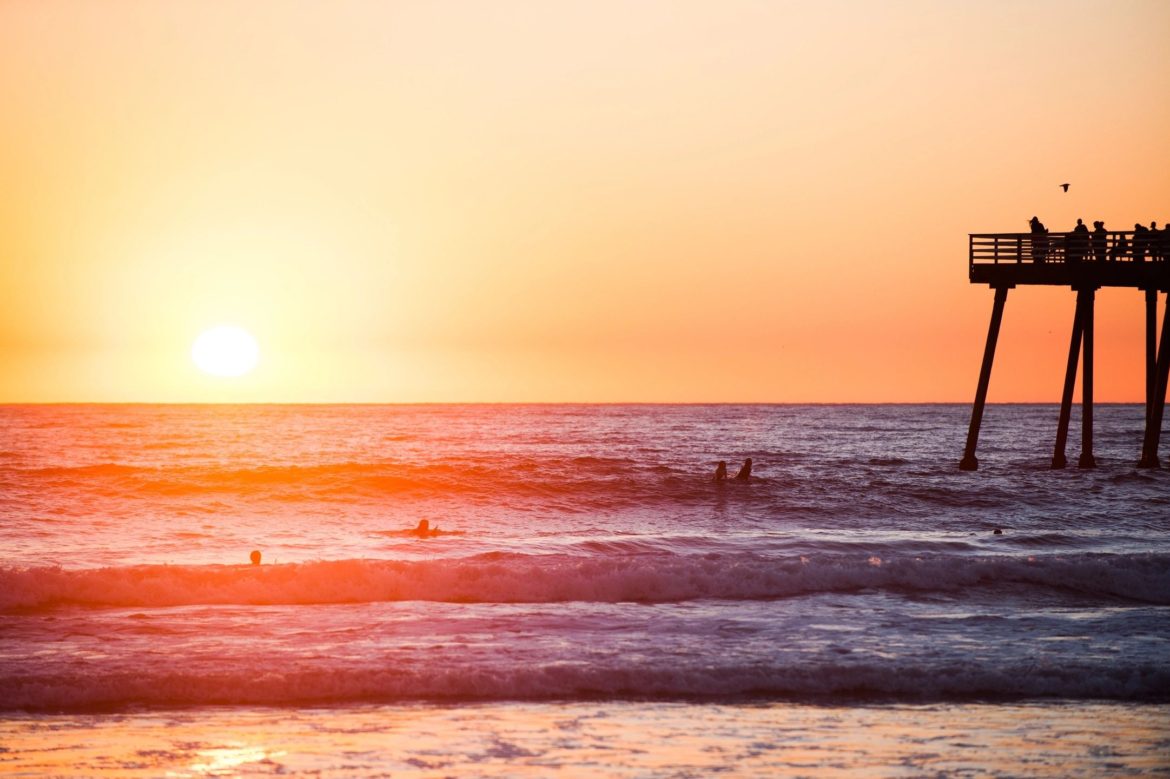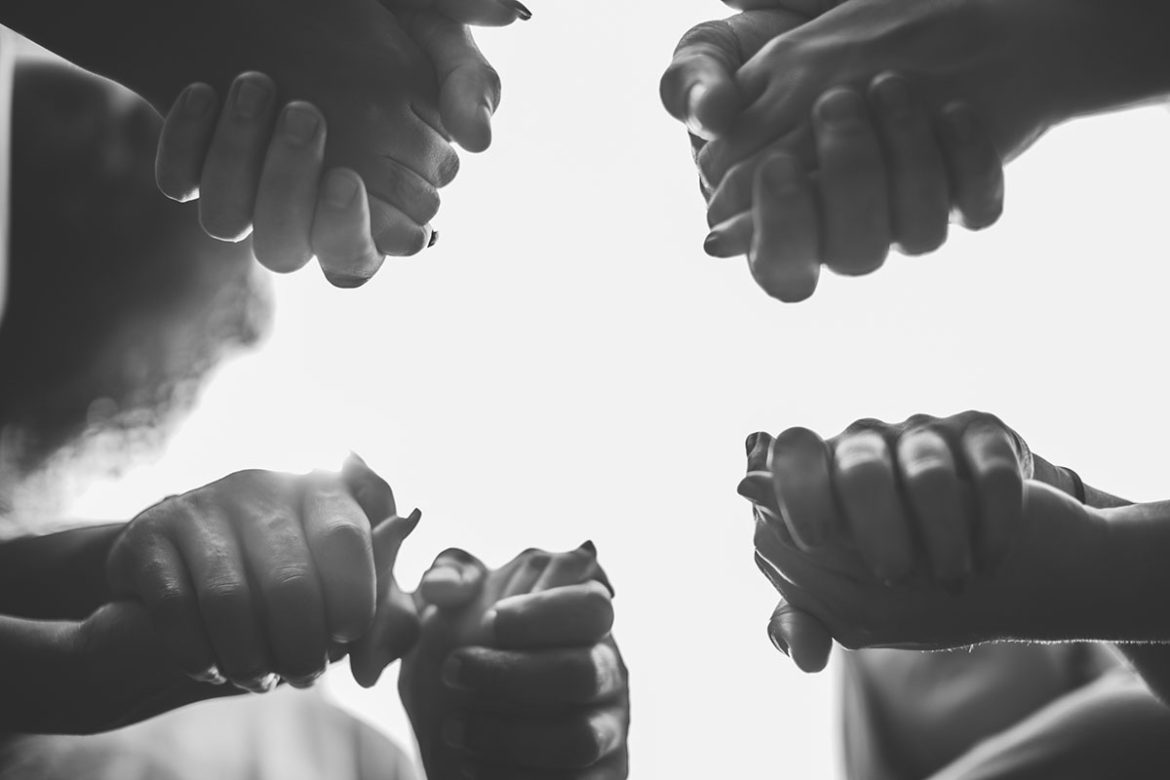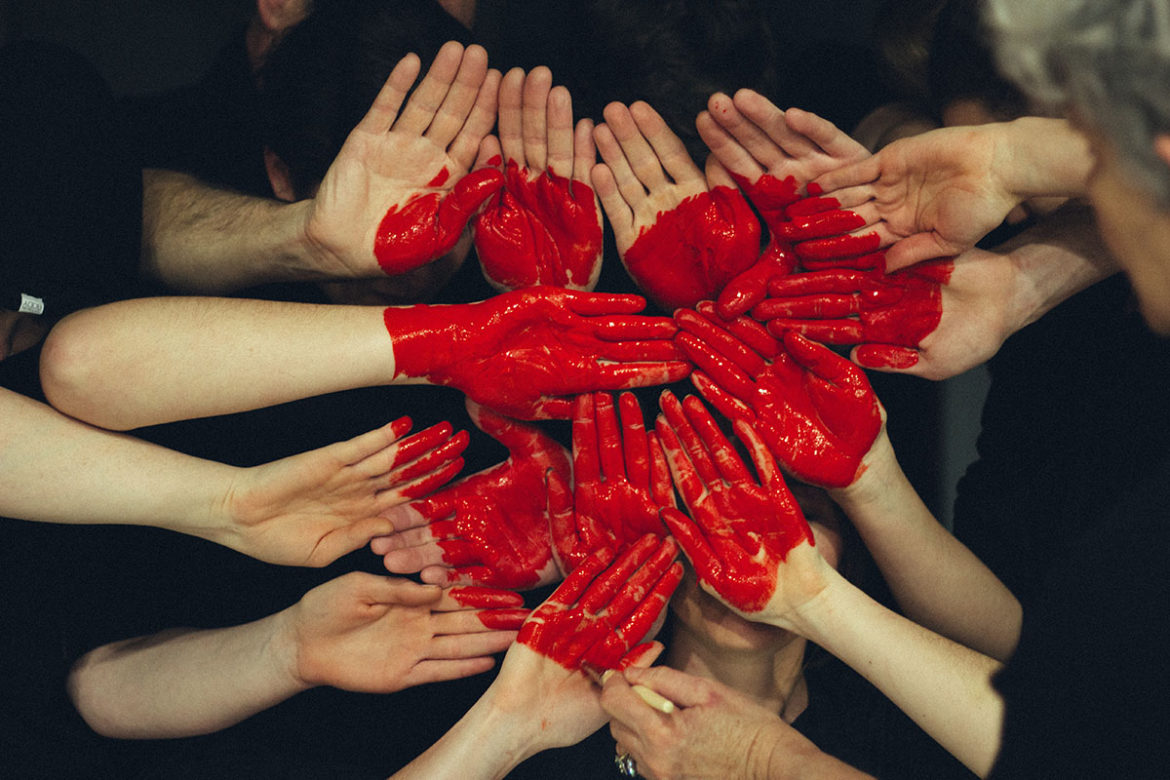By Jeannie Kendall —
As I write this I have just watched the film “Impossible”, the moving (and true) story of a family caught up in the Boxing Day tsunami of 2004. Don’t worry – no film spoilers. At one point of the film, a young boy is looking up at the stars. Someone sits beside him, and watches them too. She tells him that some of the stars that he sees have already burnt out, but they continue to shine. What is more, it is impossible to tell the difference.
Now I have no idea if that is scientifically accurate, but I found the concept both intriguing and mildly disturbing. So many in our society rocket through life, cramming more into the day than the 24 hours was ever intended to hold, afraid that stopping may somehow diminish us. Society colludes with this lie that busyness equals significance – even promoting advertisements heralding ways to keep going when we are ill with the latest cold or flu treatment. Sometimes our over-activity stems from hidden scars – we fear that the silence or stillness of inactivity may reveal turmoil we are seeking desperately to keep at bay.
Why do so many of us struggle to look after ourselves by taking rest, by sometimes saying no to the good to foster the best – our seeing ourselves as worthy of looking after just as much as those around us? People of faith can find it particularly difficult – sometimes silently articulating the underlying false theology that we need to earn God’s love. As a new Christian I was taught “Jesus-others-me” as the order of importance and the way to be a good disciple. Yet to serve God and others well we need to look after ourselves too. Jesus took rest (albeit sometimes interrupted!) and was unafraid to ask for help or companionship when he needed it.
The salutary message of that portion of the film is simple. Self-care is not an optional extra, or the lack of it a badge of honour. Indeed, if we do not listen to our bodies, minds and emotions we risk, like the stars, finding ourselves burning just as brightly but that brilliance disguising a core which has lost the life and vitality we once possessed. Jesus, it seems to me, wants something very different from that….
“Are you tired? Worn out? Burned out on religion? Come to me. Get away with me and you’ll recover your life. I’ll show you how to take a real rest. Walk with me and work with me—watch how I do it. Learn the unforced rhythms of grace. I won’t lay anything heavy or ill-fitting on you. Keep company with me and you’ll learn to live freely and lightly.” (Matthew 11:28-30, The Message)
By Talitha Fraser —
Shalom… I try and think what to write about wholeness or peace or wellbeing.
Right now, I’m not certain I know anything about that.
I kneel on the beach for a long time. Eventually, comforting words come:
Lay your burdens down, burdens down, burdens down child
I will come to you, come to you, come to you child
I will lift you up, lift you up, lift you up child
The words drip in.
Let your tears fall down…
Lay your sorrow down…
Lay your heartbreak down…
I sit until it’s too cold to stay.
Walking to warm myself the words seem to keep pace with my steps.
Lay your spirit down… Lay your body down… lay your hunger down… lay your weapons down… lay your anger down… lay your sadness down… lay your hatred down… lay your power down… lay your stigma down… lay your baggage down…
Taking some journey much further than my physical steps traverse.
I will come to you, come to you, come to you child
I will lift you up, lift you up, lift you up child
I am aware that as I pray. I am more than myself. That Eucharistic mystery that invites me to something bigger and beyond myself and reminding me of my own smallness within that means that while these words speak to my own pain, they speak to the world’s also.
This is our solace. We don’t have to go anywhere. There is no difficult ascent beyond our ability to attain. God comes to us, where we are, and does all the heavy-lifting.
Go in peace but come again… Shalom.
by Christine Sine.
This week I have been struggling. How can I celebrate this summer when so many are still dying of COVID I wonder? How can I plan a vacation when so many are being evicted from their homes? How can I rejoice with my own peaceful and comfortable existence when there is still so much violence in our world? I want to enjoy my new found freedom but not at the expense of those who have been marginalized by the pandemic.
A couple of years ago when I struggled with similar issues I came across this inspiring article Fight Fascism with A Dance Party. in Yes Magazine. It made me wonder: What are the unconventional and maybe overlooked ways to reconciliation that help turn hatred into love. What could I do this summer that will bring light and joy into the dark places of violence, aggression and displacement?
Here is a list of a few that come to mind for me:
-
- Let’s dance and sing together. I have known for a long time that singing together can lower aggression, improve mood and make people more cooperative, but had not realized (though I should have) that dance can do the same thing! No wonder David danced before the Lord. One of my most powerful memories of the last Wild Goose festival I was able to attend was of the final session where we all sang and danced together, holding hands across race, sexual orientation, and faith persuasions with young and old, rich and poor, well known and unknown. It was a profound experience that broke down barriers, and established new friendships. So I think that it is time that we all deliberately planned some gatherings across a broad swathe of society – rich and poor, young and old, from every ethnic group and every sexual persuasion we can find and plan a singing, dancing festival. I think we will be amazed at what results.
- Let’s eat together. Jesus loved to bring together people from different political and social backgrounds. He ate with the poor and the marginalized as well as the rich and the powerful, sometimes bringing both groups together in ways that made people uncomfortable but definitely helped to break down the barriers that separated them. No wonder the kingdom of God is often portrayed as a great banquet feast when all are welcomed to the table. One of my strongest symbols of summer is hospitality and as Tom and I prepare to re-engage with friends around BBQs and backyard gatherings this year I am hoping that we will be able to bring together people with different viewpoints so that we can learn from each other.
- Let’s play together. Unstructured play adds joy to life, relieves stress, supercharges learning, and connects us to others and the world around you in non threatening and barrier breaking ways. When we play well together we bond together, replace negative beliefs and behaviours with positive thoughts and actions and heal emotional wounds. I still remember a friend talking about their unfruitful attempts to connect to people in a poor community in London until one hot summer’s day a water fight broke out. By the end of the afternoon barriers had dropped and new friendships were created. I talk a lot in my latest book The Gift of Wonder about the need for play and creative ways to have fun together. You can also explore these in the online course The Gift of Wonder that we created last year. So as you get out there and have some fun this summer consider ways that you can use this to spread joy and peace and love to those who are suffering.
- Let’s work together. I have often observed that community gardens are a wonderful way to bring together people from different backgrounds – race, age, faith, sexual orientation, but other forms of community work can do the same thing. So think about what you could do together with others in your community – maybe a neighbourhood clean up day, or a building project in the local playground, or creating an art mural. The possibilities are limitless, the challenge is making sure that the attendees are diverse. It might mean some good leg work on your part, visiting local houses of worship, community centres, shops and coffee shops to let everyone know they are welcome.
What Is Your Response?
Watch the video below created by One Billion Rising, an organization that focuses on the need to end the exploitation of women. It uses dance as an effective tool to get the message across. I found this video powerful. As you watch it reflect on what you could do to break down barriers across race, culture, gender and age with the use of dance, song, or community gatherings
Could you create or participate in events that bring people together to sing, dance, play, eat or work? How could you help break down barriers to hatred, violence, discrimination, injustice by your actions?
This has been a dramatic week here in America and around the world too, with the terrorist attacks in Spain, elections in Kenya and violence in Venezuela just to name a few. I have had so many emotions that it’s been very hard to process them all. We were on vacation the last couple of weeks thus we have not had a chance to process any of this in community with thinplace (the weekly gathering we host at our home in Nashville.)
What do we do with all of the junk that is coming up in our hearts and minds?
I’ve been doing a lot of pondering on how to process all of the craziness of the last few days. Andy Wade has two great posts on living into Shalom in the midst of conflict that if you have not read, I highly recommend! Part 1 and Part 2
And part of this week’s gospel lesson is also helping me process what I am feeling.
Sunday’s gospel reading includes Matthew 15: 10-20
The Pharisees have just given Jesus and his disciples grief about the fact that they don’t wash their hands according to ritual law and they don’t “follow the rules” on all the stuff that the Pharisees think are important in order to be “IN” especially when it comes to eating
Jesus responds :
16-20 Jesus replied, “You, too? Are you being willfully stupid? Don’t you know that anything that is swallowed works its way through the intestines and is finally defecated? But what comes out of the mouth gets its start in the heart. It’s from the heart that we vomit up evil arguments, murders, adulteries, fornications, thefts, lies, and cussing. That’s what pollutes. Eating or not eating certain foods, washing or not washing your hands—that’s neither here nor there.” THE MESSAGE
and
16 “Are you still so dull?” Jesus asked them. 17 “Don’t you see that whatever enters the mouth goes into the stomach and then out of the body? 18 But the things that come out of a person’s mouth come from the heart, and these defile them. 19 For out of the heart come evil thoughts—murder, adultery, sexual immorality, theft, false testimony, slander. 20 These are what defile a person; but eating with unwashed hands does not defile them.”
It’s what we vomit up that matters to God…
What comes out of our mouths that reflects what is happening in our hearts…
So how is my heart doing?….
I feel like I’ve had too much hate and violence brewing on the edges of my heart of late.
Anger at the way our president reacted to the racism and violence in Charlottesville. Anger at the evil that lurks in the hearts of my fellow citizens. As a follower of Jesus i am called to love… to love my neighbor and pray for my enemies and those who persecute me. This is hard work today. Hard to love in the midst of so much hate and so much brokenness. And it’s hard to see the image of God and the face of Jesus reflected in a Nazi flag waving, gun toting, anger filled young man….but Jesus loves him too. Even in his hate, even in his anger, he is loved by God …but God isn’t about hate and isn’t about sides and isn’t about violence.
And too much grief that threatens to overflow into bitterness, or anger, or harshness towards other people.
I have also had to really look at my heart in terms of racism. I grew up in the South and my high school was built on a Civil War battlefield and to top it all off, our mascot was the Rebel and our fight song was “Dixie.” For all of you who did not grow up in the southern United States, that is like we were still fighting the Civil War and had the Confederate Flag as a part of each football game. Back then, I didn’t think anything about those symbols being racist, or anything about how these symbols looked to someone who is African American. They were just symbols of the South to me. Thankfully I know better now, and have grown to see how much pain these symbols cause, and how destructive and evil the love of these symbols can become. Honestly, I didn’t really have any friends who were black until after college. That really is sad, but it is the honest truth. Thankfully, my parents raised me to see that all people are equal in God’s sight, all people of all colors and creeds are God’s children. Thankfully I was raised that the KKK was evil and racism was too. This was in stark contrast to some of my relatives who were extremely prejudiced and very racist. As a kid growing up in the South, I wasn’t allowed to call the Civil War the Civil War, it was the War of Northern Aggression, or the War between the States. And when my grandmother met my future husband who is from Ohio, he was considered a “damn yankee.” And she meant it. So there is sadly, still so much of the South that is stuck in the mindset of 1855 or worse, 1865. People who are still very afraid of any change or anyone who doesn’t look or think like them. These white southerners still want to be in control and still want to dominate their world. This is not the Kingdom of God. 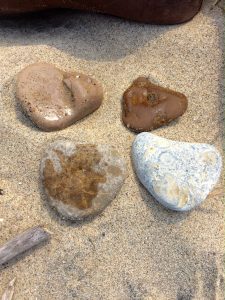
So now what?
Today I have to ask myself, Am I trying to control my world? Or am I letting God be in control?
Am I afraid? What are the things I am afraid of? Can I let Jesus hold these fears and have my anxieties about the world, politics etc?
Can I choose to love, pray for and reach out to people who don’t think like I do? Even the racist members of my family? How do I love them? How do I share the love, joy, peace, and hope of Jesus with them? And what are the tangible things I can do to bring God’s justice and mercy to my neighborhood and my city? How can I be a part of the white majority that fights as Jesus would for people still suffering in my city right now from injustice and a broken system that essentially “enslaves” them?
Yes, with God’s help I can start with baby steps in all of these things.
What about you? How is your heart today?
What do we do with all the emotions that violence, and evil, and hatred bring up in us?
For me, I need symbols and rituals to help me connect.
LIGHTING CANDLES:
We have a candle lighting ritual we do at the beginning of thinplace each Sunday night.
You can see that here.
We ask God to fill us with God’s hope, peace, joy, love and light. And when we end our time together, we blow out the candles and ask that God help us take hope, peace, joy, and love to the world and be the Light of God in our neighborhoods and jobs and schools. You can do something like this on your own, with your whole church community, or with your family around the kitchen table.
PAPER HEARTS:
This week at thinplace we will all get a handout with three heart outlines drawn on the page. See photo below.
- On the large heart we will write down all the emotions that are swirling around including all the things that are bringing us stress and pain. And take the time to really talk to God about the things in our heart.
- On one smaller heart we will write down all the things we are grateful for. Write these things down in that heart.
Gratefulness and thankfulness help us experience the shalom of God and when we see all the gifts God is giving to us we are able to give love and peace away to others.
- The second smaller heart is the heart of confession. Write down the things you want to give to God to carry for you and the things you want/need God to forgive. Write these things down in that heart.
As we close our time together, we will then give that heart to Jesus and put it at the base of a cross and allow Jesus to have the stuff that is causing our heart grief and pain and causing us to vomit things that hurt others and ourselves.
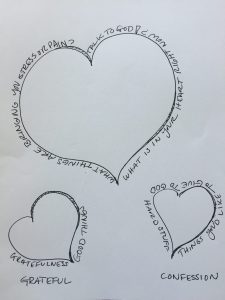
I am praying this weekend, that we all can feel God’s hope, peace, joy and love, and that we can be God’s lights in our neighborhoods, our families, in our schools and places of work so that we can share in God’s shalom for all people.
by Tom Sine.
This article is reposted from the V3 blog which Tom writes for each month.
Violence at the recent white supremacists’ demonstration at Charlottesville, Virginia alarmed Americans of all races across our country. I suspect many are surprised to learn that white supremacist, fascist and Nazi movements are all rapidly growing in America.
Christians of all cultures are having to ask the important question: As followers of Jesus, how we can be agents of racial reconciliation in times like these?
The best single Christian resource I have found on racial and reconciliation is this article from Sojourners Magazine.
For those who are involved in important work of church planting, like my friends in the V3 Movement, I have some very good news! There is rapidly growing new movement of multicultural church planting going on in America today. The even better news is that we can all be a part of it in our existing congregations and in planting new expressions of church.
Turning to a New Model of Ministry
At core this new movement is based on a new ecclesiology that I first discovered in Rodney Clapp’s important book, Families at the Crossroads. In it, he points out that the New Testament has little to say about family. However, what it does say is very radical.
Clapp reminds us of Jesus new radical description of family: “Who is my brother, sister, mother of father but he who does the will of God?” He suggests this scripture implies to become a follower of Jesus is to become a part of a new “first family” that transcends race, class and culture.
The social history of the first century church is filled with remarkable examples of followers of Jesus who indeed were creating new communities that routinely cut across race class and culture. It was a powerful witness that God was powerfully at work doing something new.
In the 80’s, the homogenous church planting efforts urged planters to create new churches on the pragmatic premise that it is easier to create new congregations with people of the same racial, cultural and class background. However, I find few young church planters who embrace that kind of pragmatism which led to 11 am Sunday morning becoming the most racially divided hour in American life.
There are a growing number of not only new church plants but also traditional congregations that are seeking to become richly diverse examples of that new “first family” that Jesus called us to join.
An Example for Consideration
At the beginning of this new millennium, First Covenant Church in Saint Paul, Minnesota, which was planted by immigrants from Sweden 140 years ago, found itself in in an increasingly racially diverse community.
The Spirit of God woke them up to this new opportunity. They started a host of new programs such a tutoring program in the racially diverse schools in the community to engage both students and parents. Now 80% of those who participate in these community programs are non-Anglo.
This led leadership in the Evangelical Covenant Church in America to start an aggressive new church planting program that included the goal of half of all new church plants would be multi-cultural and multi-racial. They also mandated creating new plants where a greater share of both congregational time and money was invested in serious change making both locally and globally.
Efrem Smith planted Sanctuary Covenant Church in a richly interracial community in north Minneapolis in 2003. It started with 22 people and grew to 900. It was 40% black, 40% white and 20% Latino and Asian. They drew upon the music, food and culture of all groups and all were invited into leadership.
Efrem spoke at one of our events at Mustard Seed Associates in Seattle in 2008 describing his growing congregation of 900 and their commitment to neighborhood transformation. They started a Community Development Corporation to help the church provide a broad range of ways to empower their most vulnerable neighbors. Remarkably Efrem told me that over 50% of the church budget was invested in local and global mission in those days.
The Evangelical Covenant Church is a part of God’s good news helping people in multicultural church plants all over America to discover we are all a part of God’s new first family. Over 30% of members in this denomination is multicultural and that number is growing.
One of the brilliant elements of this important growth of new and older multicultural cultural churches is a leadership training venture called “Journey to Mosaic.” Essentially leaders join a week-long bus trip where they sit with a leader from a different race or class than and you share your different responses to experiences that include spending a day with an African American Pentecostal church, to working and visiting with farm workers in Fresno to hanging out with the homeless in LA.
One white participant told me that he quickly discovered that he and other white leaders didn’t have all the answers, and what’s more, that they needed to become serious students of other cultures if they were going to be a constructive part of these new multicultural congregations.
I don’t know of another major denomination in the United States planting more multicultural churches or churches that are investing such a generous portion of their time and resources in making a difference in the lives of neighbors who are increasingly having difficult time supporting their families.
This your invitation, in a racially and culturally divided nation, to join our “Cov friends” by creating and planting new racially rich congregations that look more like the “new first family of Jesus” in times like these.
Today’s post, by Brian McLaren is reposted with permission from Auburn Seminary.
Last week I accepted an invitation from the Charlottesville clergy to come to their city the weekend of the Unite the Right rally, to join them in witness against white supremacy, Neo-naziism, racism, and associated evils, which are counter to both the Christian gospel and American democracy. Free speech is a protected right and we were not protesting against the rally’s right to speak; rather, we were using our right to free speech to bear witness for a better message of conciliation and peace, and we were supporting the clergy of Charlottesville to stand against the incursion of white supremacists like Richard Spencer.
Here are some initial reflections based on my experience – on the white supremacists and their message, on the clergy and faith community, on the other anti-racism protestors, on the police, and on next steps.
On the White Supremacists, Neo-nazis, and their allies: First, I was impressed by their organization. They showed up in organized caravans of rented white vans, pick-up trucks, and other vehicles, and then quickly lined up with flags and started marching. I don’t know what app they were using, but it worked. (After the state of emergency was declared, the organization seemed less effective, with more confusion and milling around.) Second, they were young. The majority, it seemed to me, were in their twenties and thirties, mostly men, but a few women. I was told by one protestor that many of the older leaders were retired military.
Many came dressed in white shirts and khaki pants, reminding me of office workers or WalMart employees. Many wore helmets and carried hand-made shields. They looked like they came expecting to fight, threaten, and intimidate. Some came in paramilitary garb, heavily armed. They carried an assortment of flags – mostly confederate, many representing their respective organizations, with a surprising number of Nazi flags. I’m 61, and before this weekend, I’ve never seen a single Nazi flag carried proudly in the United States. This weekend I saw many.
As has been widely reported, their chants included “You will not replace us,” “Jews will not replace us,” “White lives matter,” and the like. Their use of torches Fridaynight and slogans like “blood and soil” were clearly intended to evoke the KKK and Naziism. There was a good bit of “hail Trump” chanting with Nazi gestures.
Before and after the event, I have been checking a number of white supremacist websites and Facebook pages related to Unite the Right leaders and identified participants (a deeply disturbing experience) . The unabashed racism, the seething hatred, the chest-thumping hubris, the anti-Semitism, the misogyny, the shameless desire to harm their opponents, the gushing love for Trump, Putin, and Stalin, of all people … they speak for themselves. I was struck by how often the term “balls” comes up in their posts: these seem like insecure young men who are especially eager to prove their manhood, recalling election season bragging about “hand size.”
Speaking of size, I haven’t been able to find any estimate on crowd size. I would guess around a thousand white supremacists, and I would guess that the total number of anti-racism/anti-facism protesters was equal or greater.
On the clergy and faith community response: I have participated in many protests and demonstrations over the years, but I have not seen the faith community come together in such a powerful and beautiful way as they did in Charlottesville. Brittany Caine-Conley and Seth Wispelwey deserve a lot of credit, as do the Congregate C-ville team they coordinated. I hesitate to name groups represented, as I will forget someone – so please forgive me in advance. But I met UCC, Episcopal, Methodist, Unitarian, Lutheran, Baptist (Alliance), Anglican, Presbyterian, and Jewish faith leaders, and the Quakers were out in large numbers, wearing bright yellow t-shirts. I met Catholic lay people, but I didn’t meet or see any Catholic priests. Two Episcopal bishops were present, and they had encouraged priests of their diocese to be involved. Along with those of us who participated in an organized way, it was clear that many ad-hoc groups of Christians and others came to protest, some with signs, some giving out water and snacks to anti-racist protestors.
Black, white, Latino, and Asian clergy worked and stood side by side; Jews, Christians, Muslims, Buddhists, and others marched, prayed, and sang as allies.
The courage of the clergy present inspired me. In public gatherings and in private conversations before Saturday, participating clergy were warned that there was a high possibility of suffering bodily harm. A group of clergy (pictured below) walked arm-in-arm into the very center of the storm, so to speak, delaying entry to the park as they stood, sang, and kneeled. (Lisa Sharon Harper shares her reflections here.) This symbolic act took a great deal of courage, and many who did so were spat on, subjected to slurs and insults, and exposed to tear gas. I hold them in the highest regard.
Other clergy and faith leaders (I was among this group) marched to a park, participated in a rally, and then dispersed to several locations, including a Methodist church a block from Emancipation Park, where we helped medics, sang and held signs as a message to white supremacist and Nazi marchers, and provided water and other support to anti-racism protesters.
When the rally was disbanded by the police, many of us responded to reports of skirmishes and sought to de-escalate tensions. When the white supremacist terrorist driver ran into anti-racism protestors, many of us were nearby, and we ran together to the scene where we ministered to the injured and supported their loved ones. Many of us helped at the parks that were designated as “safe spaces” for anti-racism protestors, and we provided pastoral care – asking people if they were OK, listening to their stories, assisting them with finding medics, and offering them encouragement. At least a dozen times, protestors said to me, “Thanks so much to you clergy for being here.” Our presence meant something to them.
I come from a tradition that doesn’t normally use vestments, but I was glad that clergy garb made faith leaders visible in this circumstance.
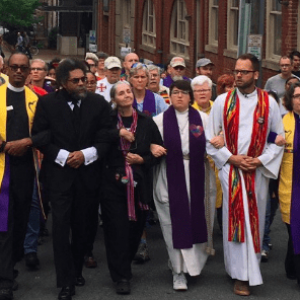
photo by Rev Steven Martin
On the other Anti-Racism Protestors: Along with Congregate C’ville, there were other groups protesting the message of white supremacy and Naziism. I was deeply impressed with the Black Lives Matter participants. They went into the middle of the fray and stood strong and resilient against vicious attacks, insults, spitting, pepper spray, tear gas, and hurled objects. It’s deeply disgusting to see BLM be vilified on Fox News and other conservative outlets after watching them comport themselves with courage in the face of vile hatred this weekend.
There were several anti-fascism groups whose exact affiliations were not easy to ascertain. I was moved by one young woman from one of these groups at the scene of the killing. She stood on a milk crate and shouted (this is a paraphrase): “People, this is hard. This is heartbreaking – to see our neighbors lying in the street, severely injured. But we must realize what’s at stake when Nazis and white supremacists want to take control of our country. We must not be intimidated, but be more committed than ever to stand against them.” There was no call to violence or revenge; only a call to resilient resistance.
I was also deeply impressed by UVA students I met. The group of young men and women that stood up to the torch-carrying marchers on Fridaynight had amazing courage. Their fellow students, their parents, and all of us, should be proud of these young leaders.
Not all of the groups shared a commitment to nonviolent resistance in the tradition of Dr. King. I saw a few groups of protestors who, like the Nazis and white supremacists, came with hand-made shields and helmets, and I heard reports that some of these groups used pepper spray on the white supremacists, who were also using pepper spray, sticks, and fists on them.
On the Police: Considering the number of guns present, it is amazing that no shots were fired, and the various police forces gathered deserve a great deal of credit for this. The local and state police had a huge challenge on their hands, and their task was very difficult. In my fields of observation, they did not seem present to intervene quickly when skirmishes broke out. They seemed to stay back in the background. Perhaps this was intentional and strategic for reasons I don’t understand. Be that as it may, I couldn’t help but think about the contrast between the hands-off way heavily armed white supremacists were treated by police in Charlotte and how unarmed African Americans in other demonstrations have been beaten and arrested around the country over the years … or how unarmed Native Americans were treated at Black Rock a few months ago. That contrast is haunting, itself an expression of white privilege.
On Next Steps: The young age of many of the white supremacists and Nazis suggests two things to me: first, that young white people are being radicalized in America today, radicalized to the point of using the ISIS tactic of killing people with a car; and second, that this problem isn’t going away fast – especially if radicalizing influences continue or increase their activities among younger generations.
What does this mean?
First, it means that white mothers, fathers, grandparents, wives, husbands, sisters, brothers, children, and pastors need to speak up when their loved ones are being radicalized. Every white American family needs to realize that radicalization isn’t simply something that happens in the Middle East – it is happening today, in Ohio and Kentucky and Florida and Virginia. And make no mistake, these are radical groups, seeking to unite and fight together.
In addition, clergy around the country must prepare now for when an event like this comes to their area – which may be sooner than they think. (I understand that Richmond has already been targeted for another such rally in a few months.) Just as male mammals seek to “mark territory,” these human groups seem determined to maintain their markers of white supremacy – namely, statues and flags associated with the era and culture of slavery. Their oddly ambiguous slogan “You will not replace us” seems to mean, “You will not replace our white supremacy.”
All of us, especially people of faith, need to proclaim that white supremacy and white privilege and all other forms of racism and injustice must indeed be replaced with something better – the beloved community where all are welcome, all are safe, and all are free. White supremacist and Nazi dreams of apartheid must be replaced with a better dream – people of all tribes, races, creeds, and nations learning to live in peace, mutual respect, and neighborliness. Such a better world is possible, but only if we set our hearts on realizing the possibility.
We Christians, in particular, need to face the degree to which white Christianity has failed – grievously, tragically, unarguably failed – to teach its white adherents to love their non-white neighbors as themselves. Congregations of all denominations need to make this an urgent priority – to acknowledge the degree to which white American Christianity has been a chaplaincy to white supremacy for centuries, and in that way, has betrayed the gospel.
Our Christian leaders need to face the deep roots of white Christian supremacy that go back to 1452 and the Doctrine of Discovery, and before that, to the tragic deals made by 4th Century Bishops with Emperor Constantine, and before that, to the rise of Christian antisemitism mere decades after Jesus. This tense season of our history needs to be, quite literally, a come-to-Jesus moment for Christianity in America.
Along with this theological and spiritual work, we have very urgent practical work to do, including 1) pre-empting the continuing development of white supremacist, Nazi, and fascist groups through preventative measures, 2) building relationships among groups that oppose racism and Naziism – both religious and secular, 3) improving planning and coordinating among these groups, and 4) addressing the ways that white supremacists and Nazis are seeking to use us as foils to win over conservative people through fear and division (which is the strategy behind Unite the Right). What is needed in all these areas (and more) will be the subject of many conversations in the coming hours, days, and weeks.
Brian D. McLaren is an author, speaker, activist, and public theologian. He is the author of The Great Spiritual Migration and an Auburn Senior Fellow.
“Therefore I tell you, do not worry about your life, what you will eat or drink; or about your body, what you will wear. Is not life more than food, and the body more than clothes? Look at the birds of the air; they do not sow or reap or store away in barns, and yet your heavenly Father feeds them. Are you not much more valuable than they? Can any one of you by worrying add a single hour to your life?” Mt. 6:25-27
In yesterday’s post, I explored this passage’s connection back to Jesus’ earlier comments in the Sermon on the Mount from the Beatitudes through the Lord’s Prayer. After his prayer, Jesus goes on to challenge us about what we value. Where is our treasure? Are we amassing wealth and power in this world while ignoring the broad purposes of God? Are we constantly pursuing our own self-interests and enjoyment while ignoring the needs around us? Do we fill our lives with distractions, pushing aside the pain, anger, and brokenness of the world?
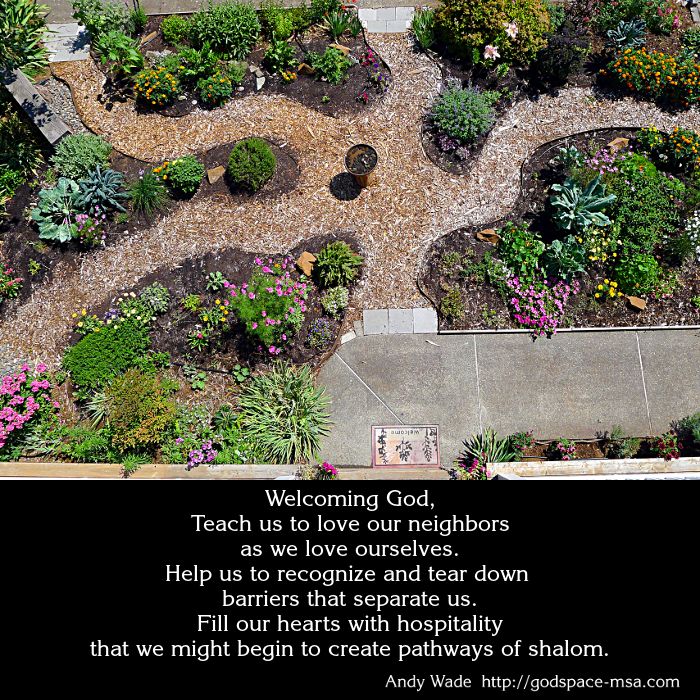 We often hear the phrase “follow the money” when it comes to uncovering the hypocrisy of others, but how often do we do this in our own lives?
We often hear the phrase “follow the money” when it comes to uncovering the hypocrisy of others, but how often do we do this in our own lives?
And then, as if to hammer this point home, Jesus makes it clear, “You cannot serve two masters”.
OK, right about now I’m not feeling so comfortable! Is Jesus laying some kind of guilt-trip on us? NO, I don’t believe it!
- I believe Jesus is attempting to expose how easily we settle for so much less than God desires for us and for the whole creation.
- I believe Jesus is trying to get us unstuck from our insecurities so that we can live fully into the purposes of shalom in the world.
- I believe Jesus is showing us a better way, a way that leads to peace, harmony, contentment, and joy.
Therefore, I tell you, do not worry about your life…”
We’ve reached the point in Jesus’ message where our key passage appears. Do not worry about your life. See how God cares for creation? Are you not more valuable in the eyes of God? God will care for you if you seek FIRST God’s kingdom purposes and God’s righteousness and justice in the world.
King Solomon amassed more possessions and power than we can even dream of having, yet he never found contentment. In fact, despite all his wealth and power, Solomon turned away from God. “You cannot serve both God and wealth.”
Faithfulness to the way of Jesus means we must resist knee-jerk reactions to injustice and other things that offend. The core of all our responses should be shalom. The radical nature and call of Jesus is a revolution that’s so counter-cultural it shocks and surprises, opening doors to dialogue and healing.
The other day when I was parking at the hospital I noticed a car had parked right on top of one of the parking lines. Then I noticed that nearly ten cars after that had to park on the lines just to have room to park. Our actions, for good and for bad, don’t just affect us; they ripple out, impacting the world around us.
“Are you serious? No way am I going to forgive that idiot!”
Often our first reaction to injustice and division is to inadvertently sow more division and cultivate more injustice. But the way of Jesus invites us to a better response. To return love for hate, forgiveness for persecution, generosity for greed.
It’s a way of healing, wholeness, and peace, and many are choosing this way to be their pattern of life.
What does shalom look like in our world today? It is a radical commitment to the kingdom purposes of God in our world.
- It looks like an Amish community in Pennsylvania whose children were slaughtered by a gunman yet chose not only to forgive but to adopt the gunman’s family as their own, demonstrating the radical love of God in the most practical terms.
- It looks like MJ Sharp, a worker for peace and reconciliation in the Democratic Republic of Congo who, along with his Swedish co-worker and Congolese translator, were murdered this past March. MJ’s father noted that if we really believe in loving our enemies, “we should be producing hundreds of MJs.” Not necessarily to do what he did, he said, but “we are all called to reach out to those who are hopeless.”
- Shalom looks like my friends Dan and Joji Pantoja, working for reconciliation and peace between Christians, Muslims, tribal peoples, and the Philippine government in Mindanao and beyond.
- Shalom looks like you and me coming alongside our Hispanic neighbors who live in fear of deportation and separated families.
- It looks like you and me embracing our neighbors who are experiencing homelessness, loving them as equals created in the image of God rather than projects to be completed or problems to be fixed.
- It looks like you and me loving our neighbors whatever their race, religion, sexual orientation, social status, or who they voted for or currently support.
- Shalom looks like you and me working for environmental, social and economic justice right here, right where we are.
“Do not worry or be anxious”, Jesus says. Worry adds nothing to your life and will only paralyze you, keeping you from living in the way God created you to live.
Worry is anti-shalom. Instead, with humility and courage, engage in God’s kingdom work in the world. Do justice, love mercy, walk humbly with God. Listen to the words of Jesus and become shalom-bearers in the world.
Yes, there is much to be concerned about in our world today.
- Where there is division, bring healing and reconciliation.
- Where there is hatred, bring love and understanding.
- Where there is fear, bring hope and joy.
We are the people of God called to a different way of living in the world. We are called to live shalom. We are called to be shalom.
As we enter this week may our hearts and minds be attentive:
- When you sense anger rising within, ask yourself, “Where does this anger come from, and how can it be transformed into shalom?”
- When you sense fear and anxiety creeping into your life, ask yourself, “What am I fearful of? Is it justified? How might God want to transform that fear and anxiety into shalom?
- When you see injustice in your community and world, ask God, “How would you like to use me, right now, as an instrument of peace, of justice, of healing and reconciliation?”
Living shalom in a world of conflict is really the heart of Jesus’ sermon on the mount. It is Jesus’ radical call to discipleship – to being the people of God in the world. It seems counterintuitive that Jesus would sum up his message with the words, “Therefore, I tell you, do not worry about your life… do not be anxious and afraid.”
Yet somehow, somewhere in the midst of seeking first the kingdom purposes of God in the world, we discover a deep sense of peace and contentment, of shalom. And that shalom begins to flow naturally from our lives to those around us.
May it be so for you, for me, and for our world.
As an Amazon Associate, I receive a small amount for purchases made through appropriate links.
Thank you for supporting Godspace in this way.
When referencing or quoting Godspace Light, please be sure to include the Author (Christine Sine unless otherwise noted), the Title of the article or resource, the Source link where appropriate, and ©Godspacelight.com. Thank you!




